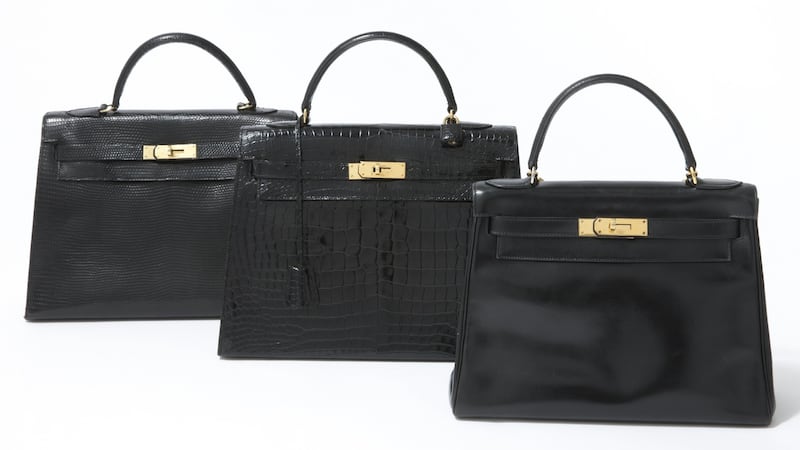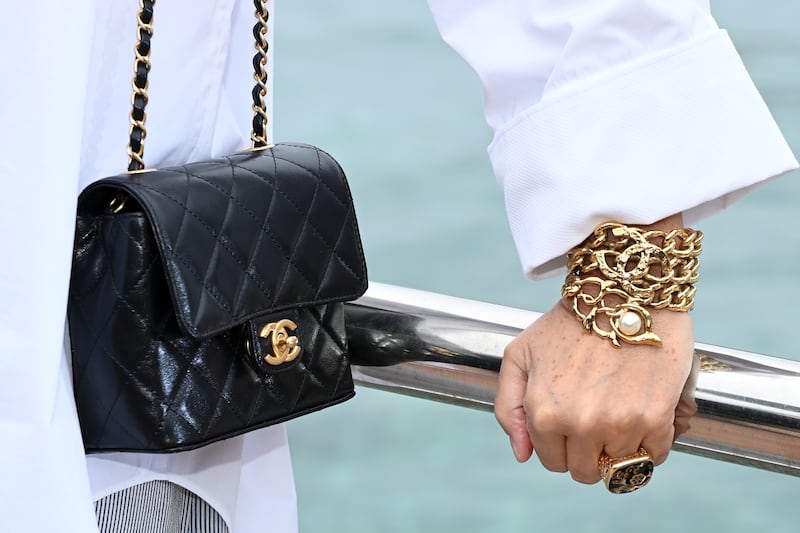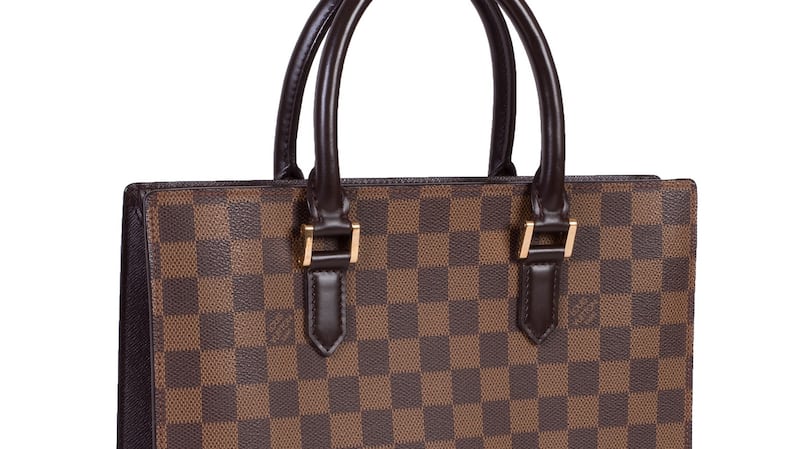She may have had a reputation for being terrible with money, but Sex and the City’s Carrie Bradshaw had something right when she famously said: “I like my money where I can see it, hanging in my closet.” Particularly if it was a wardrobe full of handbags.
Yes, as an investment, handbags – if chosen wisely and maintained carefully – can surpass the returns on offer in other assets. Not to mind looking swish on your wrist.
A couple of years ago Ella de Guzman, founder of Siopaella on Dublin’s Wicklow Street, had a lady come in with a collection of bags which she had spent a decade building up; the proceeds – about €40,000 – went towards a deposit for her first home.
It’s no surprise then that the market is booming.
READ MORE
According to business intelligence group Future Market Insights, the second-hand bag market is expected to reach a valuation of almost $10.8 billion (€10.4 billion) in 2032, up from about $6 billion this year, driven by the rise in both disposable income and demand for designer bags.
Demand is growing, the report says, due to the rise of the influence of social media and, in turn, celebrity fashion, as well as environmental concerns in choosing already used over new.
And values are also rising. According to the Knight Frank Luxury Investment Index for the fourth quarter of 2021, handbags grew by 7 per cent in the year, ahead of cars (3 per cent); jewellery (2 per cent); and furniture (1 per cent). Over a 10-year period, handbags rose in value by 78 per cent, compared with 75 per cent for art, and 64 per cent for coins.

Meg Randell, head of London auction house Bonhams Designer’s handbags and fashion department, attributes the growth in the second-hand designer handbag market to a greater understanding of the secondary market over the past eight years or so.
“The market for people willing to buy just grew,” she says, adding that internet bidding “opened it up globally”. Now, people (and it’s mostly women, Randell says) buy because they love the bags, or need to have them in their collection. “And they usually get their money back and make money as well,” she says.
[ It costs how much to boil the kettle? Take a home energy auditOpens in new window ]
It’s not just demand sending prices soaring in the secondary market; it’s also a function of price increases in the primary market.
As Randell notes, brands may increase their prices every six months, which “creates the idea that the second you can afford to buy, you buy, because if you wait even six months, you won’t be able to afford it”.
“That has a big knock-on effect on the secondary market,” she adds, noting that you might make as much as 60-80 per cent of the new price for a second-hand bag.
At high-end auction level, the big names are Hermès, Chanel and, to a lesser extent, Louis Vuitton. Other brands, such as Saint Laurent, Gucci and Prada “sell but don’t fly” says Randell, adding that Bottega Veneta could be a name to watch for the future.

Hermès, the famed French brand behind the iconic Kelly and Birkin bags, attracts the highest prices, in part, because of the way they restrict access to the primary market. Even if you have the €5,000+ required to buy such a bag new, it’s still unlikely that you’ll be able to buy one, such is the brand’s stranglehold on supply.
And if you do get an offer to buy a bag, you’ll have to buy the one that’s being offered – there won’t be a choice.
“Hermès is really the only brand that applies to,” says Randell.
So, when a bag comes up at auction, demand is invariably strong.
[ What’s so bad about cash? Reasons not to buy vouchers this ChristmasOpens in new window ]
Randell cites a Hermès bag bought new two years ago for £5,500 (€6,360). The bag, which was never taken out of its box, was sold at a Bonhams’ auction in October with a guide price of £12,000-£18,000 – but ended up selling for a staggering £35,000.
“You can’t really go wrong,” agrees de Guzman – who buys and sells designer bags at her Dublin stores – of the big three brands. But she adds that there can be a distinction with Louis Vuitton.
First of all, leather bags from the French brand tend to have a lower resale value over time – it’s the canvas Damier and Monogram options that are better at increasing in value.
If you’ve spent €8,000 on it, don’t leave it on the ground!
Sometimes more trend-led options can do well; back in 2001, bags from artist Stephen Sprouse’s collaboration with the brand sold for about €1,500 – they’re now selling for more than €3,000 she says.
One of the most popular Louis Vuitton bags is the Neverfull, which can have a resale value of €800-€1,200. “I could sell 20 of these a day,” says de Guzman, if she had the stock.
Chanel is also a good bet, with de Guzman citing the recent example of a box-fresh medium-sized black Chanel caviar flap back which sold for €8,000 in just 10 minutes.

Chanel bags also tend to hold their value well. One recent customer brought a Chanel flap bag in, with the receipt still in it, which showed it was bought for €3,700; it’s now on sale for €7,000 (its retail price new is about €10,000), which means that the client will get as much as €5,600 back, or 50 per cent more than her original investment.
And, if she had kept it in mint condition, it would have been worth an extra €1,000.
“If you’ve spent €8,000 on it, don’t leave it on the ground!” advises de Guzman, who admits to asking for an extra chair for her handbag when in a restaurant.
Currently on trend are the Fendi baguettes, popularised in the aforementioned Sex and the City. “You couldn’t give them away free 10 years ago,” de Guzman says, noting they are now once more a popular buy.
So let the head talk to the heart a little bit before making a significant purchase. “Some clients will call me before they buy something in Brown Thomas, to make sure that what they buy will have value in a couple of years,” says de Guzman.
“Bags that have been around for decades are a pretty safe bet,” says Randell, citing the aforementioned Birkin or Chanel flap bag in classic colours, such as black, navy and cream.
And if money was no object, what would the bag experts buy? Randell would opt for an emerald green Chanel classic flap bag – “they don’t make many in that colour” she says – while de Guzman also opts for Chanel, a mini rectangle black cross-body flap bag with gold hardware. “They’re so hard to find,” she says.
On the resale market, if you sell through a third party, you won’t get the full value of the sale. At Siopaella for example, you will get as much as 70-80 per cent of the sale price of a Chanel bag, but as low as 40 per cent for a Michael Kors.
And, as mentioned, the bags will need to be in good condition for the higher prices. “We do sell pieces that aren’t necessarily in perfect condition, and the price completely reflects that – but you won’t get the top, top prices,” says Randell.
If you are hoping to sell your collection – or just a bag – condition will be important. Some issues can be repaired; Hermes, for example, has a handbag spa where you can send your bag for repairs. Be careful however, as if the repairs aren’t done well, it can damage the resale value.
Given the sharp rise in value of second-hand bags, it’s likely that many of us have valuable bags stuffed in wardrobes that should be named in home insurance policies. If you’re not thinking of selling them on, de Guzman suggests getting a replacement value from a shop like hers, or go back to the original manufacturer, to ensure they are adequately covered.
Authenticity is another big issue. “It’s a real minefield,” says Randell, adding that as bags get more expensive, fakes get better all the time, so you have to be very diligent in buying on the second-hand market.
At an auction house like Bonhams, all bags are authenticated by the auction staff, as well as an independent adjudicator.
Authenticity is also key at Siopaella, “with a triple A grade fake, it’s hard to tell from far away”, but there are clues – sometimes it’s as obvious as sa “Chanell” bag, other times it’s a trickier proposition and comes down to the colour and style of the stitching, and the sheen on the leather.
De Guzman says they provide an authenticity service for the Garda, when they’re dealing with stolen goods.
Where can I sell my bags in Ireland?
- Full Circle, Arnotts and Brown Thomas
- Siopaella, Dublin
- Designer Exchange, Dublin
- Legacy Handbags, Dublin
- No. 8, Galway
- Lou’s Lot, Dublin

















